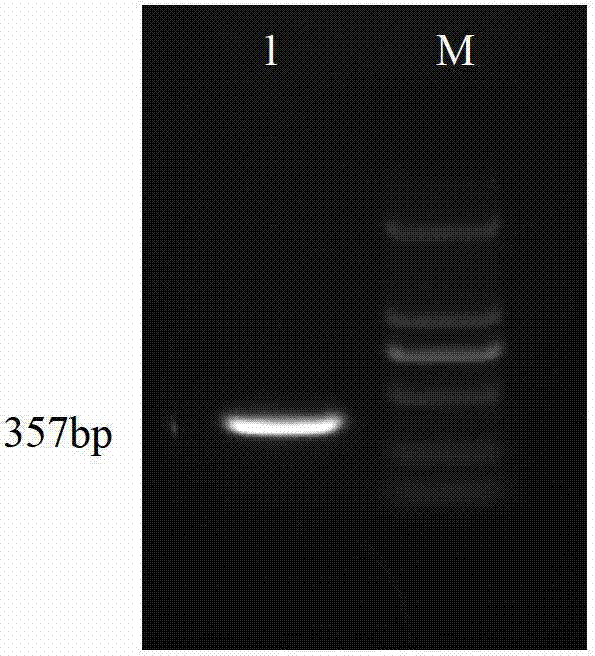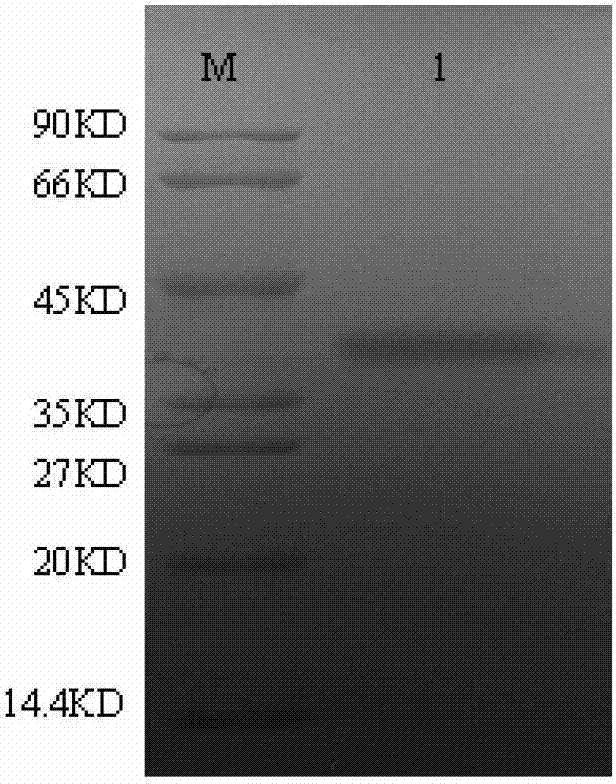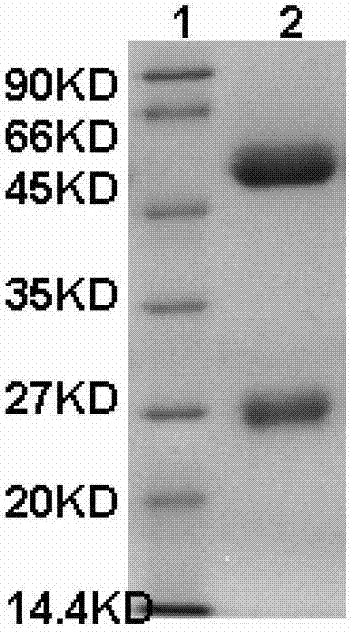Monoclonal antibody of anti-perkinsus membrane protein, preparation method and application thereof
A monoclonal antibody and membrane protein technology, applied in the field of genetic engineering and immunology, to achieve the effect of a reliable immunological detection method
- Summary
- Abstract
- Description
- Claims
- Application Information
AI Technical Summary
Problems solved by technology
Method used
Image
Examples
Embodiment 1
[0027] Example 1 Obtaining of Peyrin's membrane protein (MOE)
[0028] 1.1 Primer design
[0029] According to the sequence published in ACCESSION No.EF632302 in the NCBI Gene Bank (GenBank) of the National Center for Bioinformatics in the United States, primers were designed at both ends of the open reading frame. The primer sequence is:
[0030] CB5D4UP: 5'-GGCTGATATC GGATCC TCCTCTTGTCCCACAGGGGATGC-3' (the underline is the BamHI restriction site)
[0031] CB5D4LP: 5'-CCGCAAGCTT GTC GAC TTATGACGTAGGACATGTCGG-3' (underlined is the SalI restriction site)
[0032] 1.2 Preparation of primers
[0033] After artificially synthesizing the primers, the primers were diluted to 10 μmol / l, and the upstream and downstream primers were mixed in equal volumes at a ratio of 1:1, and stored at -20°C after aliquoting.
[0034] 1.3 Extraction of the DNA of Piedia worms
[0035] Select unhealthy or just dead Philippine clams infected with Pichinella, separate gill tissues, and extract D...
Embodiment 2
[0045] Example 2 Obtaining of Monoclonal Antibody Against Pichinensis membrane protein (MOE)
[0046] 1.1 Immunization of mice with purified Pietchenia membrane protein (MOE)
[0047] Mix the purified membranous membrane protein (MOE) and complete Freund's adjuvant in equal volumes, oscillate, emulsify, and grind into a water-in-oil chylus. to the water-in-oil state).
[0048] 1) Initial immunization: 1-80 μg of specific Pijenia membrane protein (MOE) plus Freund's complete adjuvant subcutaneously injected into mice at multiple points (generally 0.25-1 mL, 0.2 mL / spot);
[0049] 2) Second immunization: 1 week later, the dose was halved, and the mice were subcutaneously injected with Freund's incomplete adjuvant in multiple points;
[0050] 3) The third immunization: 3 days later, the dose was the same as above, and the mice were subcutaneously injected with incomplete Freund's adjuvant at multiple points (5-7 days later, blood was collected to measure the potency and detect ...
Embodiment 3
[0107] Example 3 Determination of the titer of the monoclonal antibody against Pichinensis membrane protein (MOE) (ELISA detection method)
[0108] 1) Coating: add 2 μg / ml antigen (namely the specific Pichenya membrane protein (MOE) prepared in Example 1), 100 μl / well, overnight at 4°C, wash with washing solution 3 times.
[0109] 2) Blocking: add 150 μl / well blocking solution, wash 3 times after 2 hours at 37°C, and pat dry. Store in a 4°C refrigerator for later use.
[0110] 3) Add the sample to be tested:
[0111] a. For the detection of serum / antibody / ascitic fluid titer, the first well was diluted 1:1000, followed by 1:3 gradient dilution, incubated at 37°C for 30min, washed 4 times, and patted dry.
[0112] b. For the detection of cell supernatant, take 100 μl of cell supernatant, add it to the corresponding microplate, incubate at 37°C for 30 min, wash the plate 4 times, and pat dry.
[0113] 4) Add secondary antibody: take horseradish-enzyme-labeled goat anti-mous...
PUM
 Login to View More
Login to View More Abstract
Description
Claims
Application Information
 Login to View More
Login to View More - R&D
- Intellectual Property
- Life Sciences
- Materials
- Tech Scout
- Unparalleled Data Quality
- Higher Quality Content
- 60% Fewer Hallucinations
Browse by: Latest US Patents, China's latest patents, Technical Efficacy Thesaurus, Application Domain, Technology Topic, Popular Technical Reports.
© 2025 PatSnap. All rights reserved.Legal|Privacy policy|Modern Slavery Act Transparency Statement|Sitemap|About US| Contact US: help@patsnap.com



